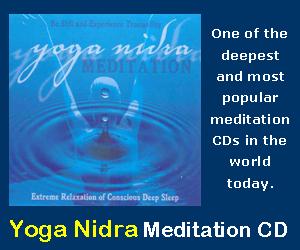|
|
61-Points
Online Guided Meditation
|
Online practice: To hear the online
61-Points Online Guided Meditation click
here. (File is large, and
may open slowly)
Part of the Yoga Nidra
CD: The 61-Points exercise is
a guided practice, systematically moving your attention through internal
points. It is used as a part of systematic yoga meditation and Yoga
Nidra (track 3 of the Yoga Nidra CD). Note that the last few
instructions of the 61-Points practice are designed to transition into
the Ascending Breath track of the Yoga Nidra CD, not to completely end
the meditation.
The practice is about 16
minutes in length.
- It is best done lying
on your back on a hard, though comfortable surface, such as a
carpeted floor.
- Put a small cushion
under the back of your head.
- Lie in such a way that
your head, neck, and spine are straight.
- Place your arms a
comfortable distance to your sides, and have the feet a comfortable
distance apart.
- After the exercise,
you might want to go deep into the space between the breasts for
yoga nidra (yogic sleep) or take a few minutes for seated
meditation.
However you experience the
points is okay:
- You may
experience the points as gross body, such as skin, muscles, or
bone
- You may experience the points as a feeling awareness.
- However you
experience the points is okay--you cannot do it wrong.
- If you
"see" with your inner eye, that's okay. If you do not
"see" with your inner eye, that's okay too.
- You may experience
darkness, or you may experience light, such as a point of light like a
blue star.
- Any way that you experience it is okay.
- Simply allow your attention to go to
the points, moving from one to the
next.
Here are the 61-Points, though you will
not need this list when following the recording:
- Forehead, throat
- Right shoulder, right elbow, right
wrist, tip of right thumb, tip of right index finger, tip of right
middle finger, tip of right ring finger, tip of right little finger,
right wrist, right elbow, right shoulder, throat
- Left shoulder, left elbow, left
wrist, tip of left thumb, tip of left index finger, tip of left
middle finger, tip of left ring finger, tip of left little finger,
left wrist, left elbow, left shoulder
- Throat, space between the breasts,
right breast, space between the breasts, left breast, space between
the breasts, navel, lower abdomen
- Right hip, right knee, right ankle,
tip of the right big toe, tip of the right second toe, tip of the
right middle toe, tip of the right fourth toe, tip of the right
little toe, right ankle, right knee, right hip, lower abdomen
- Left hip, left knee, left ankle, tip
of the left big toe, tip of the left second toe, tip of the left
middle toe, tip of the left fourth toe, tip of the left little toe,
left ankle, left knee, left hip
- Lower abdomen, navel, space between
the breasts, throat, forehead
The 61-Points exercise is an excellent
practice for entering Yoga Nidra (yogic sleep), which is a state where
you are in deep sleep, yet are awake. Yoga Nidra is deeply relaxing, and
is used by the yogis to deal with samskaras (the deep impressions that
drive karma) in their latent form.
|

-------
This site is
devoted to presenting the ancient Self-Realization path of
the Tradition of the Himalayan masters in simple,
understandable and beneficial ways, while not compromising
quality or depth. The goal of our sadhana or practices is
the highest Joy that comes from the Realization in direct
experience of the center of consciousness, the Self, the
Atman or Purusha, which is one and the same with the
Absolute Reality. This Self-Realization comes through Yoga
meditation of the Yoga Sutras, the contemplative insight of
Advaita Vedanta, and the intense devotion of Samaya Sri
Vidya Tantra, the three of which complement one another like
fingers on a hand. We employ the classical approaches of
Raja, Jnana, Karma, and Bhakti Yoga, as well as Hatha, Kriya,
Kundalini, Laya, Mantra, Nada, Siddha, and Tantra Yoga.
Meditation, contemplation, mantra and prayer finally
converge into a unified force directed towards the final
stage, piercing the pearl of wisdom called bindu, leading to
the Absolute.
|
|